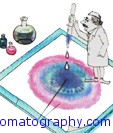From Switzerland to Russia
Posted in History on Jun 15, 2007
This is the next post from the series dedicated to 135th birthday anniversary of Prof. Tsvet, the chromatography’s founder.
Today, the application of the principle of a chromatographic substance separation is the foundation of many breakthroughs in science and technology. The analysis of the amino acid and nucleotide sequence in proteins and nucleic acids, the isolation and purification of antibiotics and the variety of other substances are all based on the chromatographic separation.
The same principle is employed in the separation of radioactive isotopes and, hence, is used in the making of nuclear weapons and nuclear power plants…
People observed “substance separation” on leaky ceilings many times before Tsvet. So, why was he able to turn these observations into a powerful modern method of substance separation?
Mikhail Semyonovich Tsvet was born in 1872 in Asti, Italy. His mother, Maria de Dorocca, – who was Italian, died shortly after the son’s birth. The father, Semen Nikolaevich Tsvet, was a descendant of a Russian merchant family. He became an important official and was quite famous in intelligentsia circles. He wrote works on literature and economics, and was a close friend of Ivan Turgenev, Victor Hugo, Alexander Gerzen, and he even dedicated a brochure “The History of Russian Nihilism” to Turgenev’s famous novel “Fathers and Sons”
Tsvet’s childhood and adolescence were spent in placid Switzerland. He graduated Geneva’s gymnasium in 1891 and straightway entered physico-mathematical faculty of the Geneva University. In 1893, Tsvet got his Bachelor of Science in physics and math. However, he decided to devote himself to studying plants. Five years later, after getting his doctoral diploma in natural science from Geneva University, Mikhail Semyonovich was already in St. Petersburg. He returned to the fatherland.
Why did he change Switzerland for Russia? There is no rational answer to this question. By coming back, he divided his own life into two, practically equal in time and opposite in “color”, halves: the bright half – the first 24 years in Switzerland, and the other dark one – the remaining 23 years before his untimely death in 1919 in Russia. Yet, it is in Russia, where he made his remarkable discovery.
3 Responses to “From Switzerland to Russia”
Leave a Reply
Tag Cloud
-
adsorbent
benzene
china
chlorophyll
chromatographic
chromatography
column chromatography
CZE
DESI
electromagnetic induction
electrospray
ELISA
eluent
explosives
forensic
furosine
Gas Chromatography
GC/MS
History
HPLC
IC
isoflavones
lab-on-a-chip
LCMS
maldi tof
Mass Spectrometry
microfluidic
nano
Nano HPLC
nanoliquid
nanoscale
nanostream
nanotechnology
nanotubes
News
organic molecule
protein
Rickettsia
rmsf
rocky mountain spotted fever
science
soy
TCM
ticks
tsvet



Hi Everyone,
Fantastic opportunity for 2 Chromatography Sales Specialist! One based in the Nordic (West Russia / Scandinavia) & the other based in South West Europe (Spain/Portugal/Italy)
Working for a leading supplier of scientific technology, you will provide sales expertise to scientists based at a wide variety of organisations within the chromatography markets. Ideally you will have a strong background in HPLC and GC and scientific sales experience.
You will be driven and proactive; seeking to establish new business relationships and nurturing existing ones. For further information or to apply for the role, email doreen.belonwu@thermofisher.com, or visit our website http://www.thermofisher.com
Kyle, thank you for the comment!
Regarding, Prof. Tsvet’s “dark half” .. I have not finished this post series and in the next installment I will talk about his life in Russia, so then you may see the correlation.
Thanks again!
Do you really feel that his dark half was Russia?
Maybe it was not as dark as you think, or maybe it was conductive to the advancement of chromatography!
Looks like he educated in Switzerland and did his deepest thinking in Russia!!
I like the article. Now I will read all the rest of the links…
Kyle Keeton